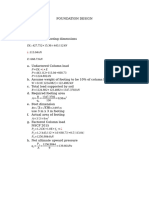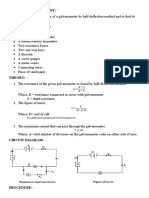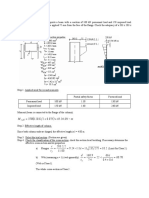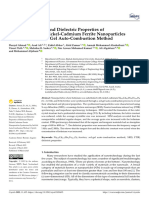15 To 18
15 To 18
Uploaded by
Kommiredypradeepkumar KumarCopyright:
Available Formats
15 To 18
15 To 18
Uploaded by
Kommiredypradeepkumar KumarOriginal Description:
Original Title
Copyright
Available Formats
Share this document
Did you find this document useful?
Is this content inappropriate?
Copyright:
Available Formats
15 To 18
15 To 18
Uploaded by
Kommiredypradeepkumar KumarCopyright:
Available Formats
REFRACTIVE INDEX OF MATERIAL OF PRISM
FORMULA:
A + Dm
sin
Refractive index of the prism = 2 No units
A
sin
2
Where 𝐴 = angle of the prism in degree
𝐷𝑚 = angle of minimum deviation in degree
TABLE :- To determine the angle of minimum deviation
Angle of incidence Angle of deviation
Sl. No.
𝑖 in degree 𝑑 in degree
1 30 44
2 35 40
3 40 37 ( 𝐷𝑚 )
4 45 39
5 50 42
6 55 46
Angle of minimum deviation 𝐷𝑚 = 37 degree
CALCULATION :
A + Dm
sin
= 2
A
sin
2
60 + 37
sin
2
=
60
sin
2
sin 48.5
=
sin 30
= 1.497 ( No Units)
OBSERVATIONS:
1. Angle of minimum deviation from graph = 37°
2. Angle of the prism = 60°
3. Refractive index of the prism = 1.497 ( 𝑁𝑜 𝑈𝑛𝑖𝑡𝑠 )
S B S ( 8500 142 144 ) page | 1
SCALE :
On X – axis 1 unit = 10 degree
On Y – axis 1 unit = 10 degree
Sl. Angle of Angle of
No incidence deviation
𝑖 in degree 𝑑 in degree
1 30 44
2 35 40
3 40 37
4 45 39
5 50 42
6 55 46
RESULT:
Refractive index of the prism = 1.497 ( 𝑁𝑜 𝑈𝑛𝑖𝑡𝑠 )
S B S ( 8500 142 144 ) page | 2
TANGENT GALVANOMETER
FORMULA:
Strength of electric current flowing in the circuit i = K Tan A
10rH
Where K is reduction factor K = 𝐴𝑚𝑝𝑒𝑟𝑒
2 n
𝑟 = radius of the coil
𝐻 = horizontal component of earth’s magnetic field = 0.38 𝑂𝑒𝑟𝑠𝑡𝑒𝑑
𝑛 = number of turns
𝜃 = Average deflection of T .G in degree
TABLE : Determine the strength of electric current in the circuit
Sl. Ammeter reading Deflections in T.G Mean θ
No 𝑖 amp 1 2 3 4 degree Tan θ i = K Tan
1 1.4 30 30 30 30 30 0.5773 1.38
2 1.6 36 36 32 32 34 0.6745 1.59
3 1.8 39 39 35 35 37 0.753 1.81
4 2.0 41 41 39 39 40 0.839 2.01
5 2.2 45 45 40 40 42.5 0.913 2.20
6 2.4 47 47 43 43 45 1 2.4
CALCULATION :
10 r H
Reduction factor K= A
2 n
10 7.95 0.38
= = 2.404 A
2 3.14 2
OBSERVATIONS:
50
1. 𝑟 = radius of the coil = 𝑐𝑚 = 7.95 𝑐𝑚
2
2. 𝑛 = number of turns = 2
RESULT:
Strength of electric current is calculated and verified using ammeter
Reduction factor of TG 𝑘 = 2.404 𝐴
S B S ( 8500 142 144 ) page | 3
OHMS LAW
FORMULA:
To verify the Ohms law ( R+B+G ) Tan θ = constant
Where R = resistance in resistance box in Ω
B = resistance of battery in Ω
G = resistance of tangent galvanometer in Ω
θ = Average deflection in T G in degree
TABLE : To verify ohms law
Resistance in Deflections in T G
Sl. Mean θ in
resistance degree (𝑅 + 𝐵 + 𝐺)𝑇𝑎𝑛𝜃
No degree 𝑇𝑎𝑛𝜃 𝐶𝑜𝑡𝜃
box 𝑅 Ω 1 2 3 4 = constant
1 2 52 52 58 58 55 1.428 0.7 18.56
2 4 48 48 53 53 50.5 1.2 0.824 18
3 6 45 45 50 50 47.5 1.091 0.916 18.547
4 8 43 43 48 48 45.5 1.017 0.982 19.33
5 10 40 40 43 43 41.5 0.884 1.130 18.56
6 12 36 36 40 40 38 0.781 1.279 17.96
OBSERVATIONS:
From graph value of (B+G ) = 11 Ω
RESULT :-
Ohms law is verified
Resistance in
Sl.
resistance
No 𝐶𝑜𝑡𝜃
box 𝑅 Ω
1 2 0.7
2 4 0.824
3 6 0.916
4 8 0.982
5 10 1.130
6 12 1.279
SCALE:
On X – axis 1 unit = 2
On Y – axis 1 unit = 0.1
S B S ( 8500 142 144 ) page | 4
METRE BRIDGE
FORMULA:
Dis tan ce moved on pitch sca le 5mm
pitch of the screw = = = 1mm
No. of rotations 5
Pitch of the screw 1mm
Least count = = = 0.01 mm
No. of divisions on head scale 100
l
Resistance of the given wire x = R 1
l2
r2
Specific resistance of the wire = x cm
l
Where
𝑥 = Resistance of the unknown wire Ω
𝑅 = Resistance in the right gap Ω
l1 = Balancing length from left in cm
l2 = Balancing length from right in cm
r = Radius of the wire in cm
l = Length of the wire in cm
Rs + Rs2 − 4 Rs Rp
Individual resistance of 1st wire R1 =
2
Rs − Rs2 − 4 Rs Rp
Individual resistance of 2nd wire R2 =
2
Where
𝑅𝑠 = Effective resistance when 𝑅1 , 𝑅2 are connected in series in Ω
𝑅𝑝 = Effective resistance when 𝑅1 , 𝑅2 are connected in parallel in Ω
TABLE : To determine the radius of given wire
Error : + 1 Correction : − 1
Sl Pitch scale Head scale reading Fraction Total
No reading Observed Correction 𝑏 = 𝑛 × 𝐿. 𝐶 (𝑎 + 𝑏) mm
a mm n mm
1 1 5 4 0.04 1.04
2 1 5 4 0.04 1.04
3 1 4 3 0.03 1.03
4 1 5 4 0.04 1.04
5 1 4 3 0.03 1.03
6 1 5 4 0.04 1.04
Average diameter of the wire 𝑑 = 1.0366 𝑚𝑚
= 0.10366 𝑐𝑚
Radius of the wire 𝑟 = 0.05183 𝑐𝑚
S B S ( 8500 142 144 ) page | 5
TABLE: Determination of resistance of the wire
Resistance in the gaps Balancing lengths Resistance of the wire
Sl.no From left From right l
x=R 1
Left 𝑥 Ω Right 𝑅 Ω
l1 cm l2 cm l2
1 𝑥 2 75 25 6
2 𝑥 4 60 40 6.08
3 𝑥 6 50.2 49.8 6.048
4 𝑥 8 43.8 56.2 6.09
5 𝑥 10 37.5 62.5 6
6 𝑥 12 33.5 66.5 6.04
Average resistance of the wire 𝑥 = 6.043 Ω
CALCULATION :
r2
Specific resistance =x cm
l
6.043 3.141 ( 0.05183 ) 10 − 4
2
=
100
= 0.0005098 cm.
TABLE: Determination of individual resistances of each wire
Resistance of
Resistances in gaps Balancing lengths
combination
Sl. Combination From left From right l
no of the wires Left 𝑥 Ω Right 𝑅 Ω x=R 1
l1 cm l2 cm l2
1 𝑥 10 54.9 45.1 12.17
2 Series 𝑥 12 50.3 49.7 12.14
3 𝑥 14 47.4 52.6 12.61
4 𝑥 2 59.3 39.7 2.987
5 Parallel 𝑥 3 49.7 50.3 2.964
6 𝑥 4 42.7 58.3 2.92
Average resistance in series combination Rs = 12.30 Ω
Average resistance in parallel combination Rp = 2.957 Ω
CALCULATION :
Rs + Rs2 − 4 Rs Rp
Resistance of 1st wire R1 =
2
12.30 + 12.302 − 4 x 12.30 x 2.957
=
2
= 7.354 Ω
S B S ( 8500 142 144 ) page | 6
Rs − Rs2 − 4 Rs Rp
Resistance of 2nd wire R2 =
2
12.30 − 12.302 − 4 x 12.30 x 2.957
=
2
= 4.945 Ω
OBSERVATIONS:
1. Pitch of the screw = 1 𝑚𝑚
2. Least count of screw gauge = 0.01 𝑚𝑚
3. Resistance of the wire 𝑥 = 6.043 Ω
4. Radius of the wire 𝑟 = 0.05183 𝑐𝑚
5. Length of the wire 𝑙 = 100 𝑐𝑚
6. Specific resistance of the given wire 𝜌 = 0.0005098 Ω cm
RESULT :-
Resistance of the given wire 𝑥 = 6.043 Ω
Specific Resistance of the given wire 𝜌 = 0.0005098 Ω cm.
Individual resistances of two wires 𝑅1 = 7.354 Ω
𝑅2 = 4.945 Ω
S B S ( 8500 142 144 ) page | 7
You might also like
- OpenStax Physics-Student Solution ManualDocument240 pagesOpenStax Physics-Student Solution ManualJackKingsman80% (15)
- Anchor Chair Design - Version 1Document3 pagesAnchor Chair Design - Version 1Rey Fiedacan100% (3)
- IEc 60898-1 - 2019Document46 pagesIEc 60898-1 - 2019Hop100% (1)
- Errors and Improvement For Physics PracticalDocument7 pagesErrors and Improvement For Physics PracticalSyafiq Shazwan67% (12)
- Bending-Stress - 19 APRILDocument11 pagesBending-Stress - 19 APRILΓιώργος ΜουσουλλοςNo ratings yet
- Uncertainty - Tensile Testing FinalDocument9 pagesUncertainty - Tensile Testing FinalJoby George100% (1)
- Universal Motor 28th Apr 2020Document5 pagesUniversal Motor 28th Apr 2020Sourav KumarNo ratings yet
- Type 1 JKT Upending Padeye CHKDocument9 pagesType 1 JKT Upending Padeye CHKRamesh SelvarajNo ratings yet
- Project CalculationDocument22 pagesProject CalculationHafizSikandarNo ratings yet
- Physics Practical Hss Second Year em - 2023-24Document17 pagesPhysics Practical Hss Second Year em - 2023-24bhuvanesharun777No ratings yet
- Solution,: K β +∅) β .sin (β−δ)Document8 pagesSolution,: K β +∅) β .sin (β−δ)Arjun BaralNo ratings yet
- Input Data - General: Stresses in Unstiffened CylindersDocument20 pagesInput Data - General: Stresses in Unstiffened CylindersDipak BorsaikiaNo ratings yet
- ME 307 Mechanical Measurements Laboratory Department of Mechanical Engineering I.I.T.BombayDocument5 pagesME 307 Mechanical Measurements Laboratory Department of Mechanical Engineering I.I.T.Bombayarvind muraliNo ratings yet
- Physics JournalDocument12 pagesPhysics JournalSHRUTI CHAVANNo ratings yet
- FOUNDATION 3-okDocument4 pagesFOUNDATION 3-okjulex marcelinoNo ratings yet
- Unsolved QuestionsDocument19 pagesUnsolved QuestionsHarsh Kumar EnameNo ratings yet
- COMMEDIA ClassXlabobservations1 20241127221304Document13 pagesCOMMEDIA ClassXlabobservations1 20241127221304kruthikundanakak12No ratings yet
- Reference: AISC Anchor Chair /pressure Vessel Handbook by Moss and BasicDocument3 pagesReference: AISC Anchor Chair /pressure Vessel Handbook by Moss and Basicswarnamalini0% (1)
- Design of Two Way Slab (With Beams) by DDMDocument23 pagesDesign of Two Way Slab (With Beams) by DDMNafees Imitaz94% (17)
- FOUNDATION 4-okDocument4 pagesFOUNDATION 4-okjulex marcelinoNo ratings yet
- Solution To Homework #3 For Chemical Engineering ThermodynamicsDocument7 pagesSolution To Homework #3 For Chemical Engineering Thermodynamicsramesh pokhrelNo ratings yet
- Earthquake Load Computation FinalDocument11 pagesEarthquake Load Computation FinalJet JavierNo ratings yet
- Channel Type Tension FittingDocument4 pagesChannel Type Tension FittingJohnclaude ChamandiNo ratings yet
- PRACTICA SOLITOSDocument12 pagesPRACTICA SOLITOSgojanjim10No ratings yet
- Worksheet 5 - Compression Member-1Document4 pagesWorksheet 5 - Compression Member-1alwabantsepe529No ratings yet
- 14 Electrical CircuitsDocument19 pages14 Electrical CircuitsApplicable AppleNo ratings yet
- Chapter 12 - SI - Final SolutionsDocument10 pagesChapter 12 - SI - Final SolutionsDouglas FernandesNo ratings yet
- Hall Yarborough ZDocument4 pagesHall Yarborough ZDanny MoralesNo ratings yet
- T T T T T: PC G NDocument3 pagesT T T T T: PC G NSig BahaNo ratings yet
- Hall Yarborough ZDocument3 pagesHall Yarborough ZTy LeNo ratings yet
- Hall Yarborough ZDocument3 pagesHall Yarborough ZicaNo ratings yet
- Hall Yarborough ZDocument3 pagesHall Yarborough ZicaNo ratings yet
- Hall Yarborough ZDocument3 pagesHall Yarborough Zvictor javier nuñezNo ratings yet
- Roark's - Discontinuity Stress at Junction of Shell & HeadDocument13 pagesRoark's - Discontinuity Stress at Junction of Shell & HeadRey FiedacanNo ratings yet
- Dimensions of Sprocket: Single-Strand Double-Strand Quadrup-StrandDocument1 pageDimensions of Sprocket: Single-Strand Double-Strand Quadrup-Strandวิทวัส นิเทียนNo ratings yet
- +2 Physics Practical Readings 2019-2020Document11 pages+2 Physics Practical Readings 2019-2020Barkath Shalu100% (1)
- L02 - Calculation of Modulus - Settlement - RotationDocument41 pagesL02 - Calculation of Modulus - Settlement - RotationKhairul NayanNo ratings yet
- Probset#4Document6 pagesProbset#4Henry Darius NamocNo ratings yet
- University of Engineering and Technology Lahore Department of Chemical EngineeringDocument10 pagesUniversity of Engineering and Technology Lahore Department of Chemical EngineeringahmadNo ratings yet
- Column Design SheetDocument3 pagesColumn Design Sheetaimkcl90No ratings yet
- Rob RCD.3Document3,258 pagesRob RCD.3RobbieNo ratings yet
- 2.0 Band Brake Example ProblemsDocument10 pages2.0 Band Brake Example Problemsmanalo.jonmeloNo ratings yet
- Workbook Workbook Workbook Workbook Workbook: Try Yourself QuestionsDocument10 pagesWorkbook Workbook Workbook Workbook Workbook: Try Yourself QuestionsarunNo ratings yet
- Half Deflection of GalvanometerDocument3 pagesHalf Deflection of GalvanometerTamanna NayakNo ratings yet
- Solutions To Test 07Document29 pagesSolutions To Test 07Princess Gupo TañasNo ratings yet
- Answers To Seatwork No 2Document5 pagesAnswers To Seatwork No 2kNo ratings yet
- Lab 1 AdvanceDocument11 pagesLab 1 Advancezaiful hakimNo ratings yet
- Chapter 12Document8 pagesChapter 12bacha01No ratings yet
- Cric Bun AkDocument26 pagesCric Bun AkGabriel AkNo ratings yet
- Chapter 5Document3 pagesChapter 5Gamtesa EjetaNo ratings yet
- Elaborati 2-Complete1Document28 pagesElaborati 2-Complete1arianit thaqiNo ratings yet
- Cable CalculationDocument4 pagesCable CalculationarunmozhiNo ratings yet
- Highway EngineeringDocument5 pagesHighway EngineeringSammy SafoNo ratings yet
- Physics Practical PDF - 12hhhDocument54 pagesPhysics Practical PDF - 12hhhmyjadavfamilyNo ratings yet
- Importent FormulasDocument158 pagesImportent FormulasmeseretNo ratings yet
- Eamples On Compression MemberDocument27 pagesEamples On Compression MemberNahili wondimuNo ratings yet
- ColumnDocument6 pagesColumnFadil FdlNo ratings yet
- Circuito 1:: Practica 3Document5 pagesCircuito 1:: Practica 3David Alejandro Diaz RinconNo ratings yet
- Act1 SpecDocument14 pagesAct1 Specabandiola3819qcNo ratings yet
- Structural Computation: Prepared byDocument7 pagesStructural Computation: Prepared byJing JingNo ratings yet
- FC-3RLY4 Analog Input, 4-Point Relay Limit Alarm Module: Product GuideDocument2 pagesFC-3RLY4 Analog Input, 4-Point Relay Limit Alarm Module: Product GuideOel NaubNo ratings yet
- Integrated Microelectronic Devices ch3 SolutionDocument14 pagesIntegrated Microelectronic Devices ch3 Solutionexplore THNo ratings yet
- Social Studies HomeeorkDocument5 pagesSocial Studies HomeeorkNoha badrNo ratings yet
- Single Phase TransformerDocument29 pagesSingle Phase Transformerkaran nirmala gajanan shindeNo ratings yet
- PhotochemistryDocument16 pagesPhotochemistryaswathyNo ratings yet
- Magnetic Material Selection For EMI Filters PDFDocument7 pagesMagnetic Material Selection For EMI Filters PDFwnaci100% (2)
- Know About AlignmentDocument58 pagesKnow About AlignmentHamdi Mohamed100% (2)
- Eltek-Rectivier Power Core DSDocument5 pagesEltek-Rectivier Power Core DSDr.Ahmed GhareebNo ratings yet
- Dynamic Soil Structure Interaction - John P.wolf 148Document1 pageDynamic Soil Structure Interaction - John P.wolf 148Mahmoud MadanyNo ratings yet
- Fix Me From Being TwistedDocument43 pagesFix Me From Being TwistedKarren Ferrer-Mora HandayanNo ratings yet
- Sa 275Document9 pagesSa 275ismaelarchilacastilloNo ratings yet
- 2.1.B - Electricity and Electronics NewDocument17 pages2.1.B - Electricity and Electronics Newmaha mohNo ratings yet
- Danyal Ahmad Crystals PublicationDocument11 pagesDanyal Ahmad Crystals PublicationDanyalAhmadNo ratings yet
- Bhramastra NEET Test Series Offline 2024Document3 pagesBhramastra NEET Test Series Offline 2024cobetax853No ratings yet
- Ce PD AlDocument11 pagesCe PD Alaustriav1No ratings yet
- Hutchison Effect and Classical Z0 ForceDocument6 pagesHutchison Effect and Classical Z0 ForceFabrice BresilNo ratings yet
- Aerial Photograph Types and CharacteristicsDocument15 pagesAerial Photograph Types and Characteristics3056 KuldeepNo ratings yet
- 4matic Siwes 2Document23 pages4matic Siwes 2stephen akinadeNo ratings yet
- 2009 IB Physics - SL Fields MSDocument7 pages2009 IB Physics - SL Fields MSGajendraNo ratings yet
- Electro MagnetDocument18 pagesElectro Magnetshikharvashishtha1729No ratings yet
- Classical MechanicsDocument20 pagesClassical MechanicsIvan Murillo OlivasNo ratings yet
- J249 04 Paper Dec 17Document24 pagesJ249 04 Paper Dec 17yufm2008No ratings yet
- Department of Education: Republic of The PhilippinesDocument3 pagesDepartment of Education: Republic of The PhilippinesDranshin San JuanNo ratings yet
- 385c EscavadoraDocument4 pages385c EscavadoraVenpulpo ZeñaNo ratings yet
- Autonics Panels MP5W Data Trace AutomationDocument26 pagesAutonics Panels MP5W Data Trace AutomationSatu WhandaruNo ratings yet
- Tianjie Cable 1.5mm2x2C SOLID UL ListedDocument2 pagesTianjie Cable 1.5mm2x2C SOLID UL Listedengr.kamrul.fireNo ratings yet

























































































